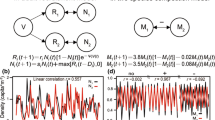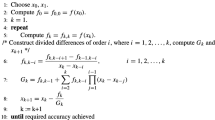Abstract
This paper presents a new parameter estimation method for Itô diffusions such that the resulting model predicts the equilibrium statistics as well as the sensitivities of the underlying system to external disturbances. Our formulation does not require the knowledge of the underlying system, however, we assume that the linear response statistics can be computed via the fluctuation–dissipation theory. The main idea is to fit the model to a finite set of “essential” statistics that is sufficient to approximate the linear response operators. In a series of test problems, we will show the consistency of the proposed method in the sense that if we apply it to estimate the parameters of the underlying model, then we must obtain the true parameters.




Similar content being viewed by others
References
Anderson, D.F., Mattingly, J.C.: A weak trapezoidal method for a class of stochastic differential equations. Commun. Math. Sci. 9(1), 301–318 (2011)
DelSole, T.: Can quasigeostrophic turbulence be modeled stochastically? J. Atmos. Sci. 53(11), 1617–1633 (1996)
Evans, D.J., Morriss, G.P.: Statistical Mechanics of Nonequilibrium Liquids. Academic Press, London (2008)
Gamerman, D., Lopes, H.F.: Markov Chain Monte Carlo: Stochastic Simulation for Bayesian Inference, Second Edition. Chapman & Hall/CRC Texts in Statistical Science. Taylor & Francis, Oxford (2006)
Gottwald, G.A., Wormell, J.P., Wouters, J.: On spurious detection of linear response and misuse of the fluctuation–dissipation theorem in finite time series. Physica D 331, 89–101 (2016)
Hairer, M., Majda, A.J.: A simple framework to justify linear response theory. Nonlinearity 23(4), 909 (2010)
Kubo, R.: The fluctuation–dissipation theorem. Rep. Prog. Phys. 29(1), 255 (1966)
Leith, C.E.: Climate response and fluctuation dissipation. J. Atmos. Sci. 32(10), 2022–2026 (1975)
Majda, A., Wang, X.: Linear response theory for statistical ensembles in complex systems with time-periodic forcing. Commun. Math. Sci. 8(1), 145–172 (2010)
Majda, A.J.: Introduction to Turbulent Dynamical Systems in Complex Systems. Springer, New York (2016)
Majda, A.J., Abramov, R.V., Grote, M.J.: Information Theory and Stochastics for Multiscale Nonlinear Systems. CRM Monograph Series, vol. 25. American Mathematical Society, Providence (2005)
Majda, A.J., Gershgorin, B.: Improving model fidelity and sensitivity for complex systems through empirical information theory. Proc. Nat. Acad. Sci. 108(25), 10044–10049 (2011)
Majda, A.J., Gershgorin, B.: Link between statistical equilibrium fidelity and forecasting skill for complex systems with model error. Proc. Nat. Acad. Sci. 108(31), 12599–12604 (2011)
Majda, A.J., Qi, D.: Improving prediction skill of imperfect turbulent models through statistical response and information theory. J. Nonlinear Sci. 26(1), 233–285 (2016)
Majda, A.J., Qi, D.: Strategies for reduced-order models for predicting the statistical responses and uncertainty quantification in complex turbulent dynamical systems. submitted to SIAM Rev. (2016)
Noid, W.G.: Perspective: coarse-grained models for biomolecular systems. J. Chem. Phys. 139(9), 090901 (2013)
Pavliotis, G.A.: Stochastic Processes and Applications: Diffusion Processes, the Fokker–Planck and Langevin Equations. Texts in Applied Mathematics. Springer, New York (2014)
Qi, D., Majda, A.J.: Low-dimensional reduced-order models for statistical response and uncertainty quantification: two-layer baroclinic turbulence. J. Atmos. Sci. 73(12), 4609–4639 (2016)
Riniker, S., Allison, J.R., van Gunsteren, W.F.: On developing coarse-grained models for biomolecular simulation: a review. Phys. Chem. Chem. Phys. 14(36), 12423 (2012)
Risken, H.: Fokker–Planck Equation. Springer, New York (1984)
Toda, M., Kubo, R., Hashitsume, N.: Statistical Physics II. Nonquilibrium Statistical Mechanics. Springer, New York (1983)
Acknowledgements
The research of JH and XL was supported by the NSF Grant DMS-1619661. JH also acknowledges supports from DMS-1317919, ONR Grant N00014-16-1-2888 and ONR MURI Grant N00014-12-1-0912. XL also acknowledges support from NSF Grant DMS-1522617. HZ was partially supported as a GRA under the NSF Grant DMS-1317919.
Author information
Authors and Affiliations
Corresponding author
Appendices
Appendix 1: The Computation of \(M_2\) for the Simplified Turbulence Model
Here, we provide the computational detail for obtaining (27). In particular,
where \(\tilde{B}(x,x)=(\tilde{B}_1x_2x_3,\tilde{B}_2x_1x_3,\tilde{B}_3 x_1x_2)\) and \(\tilde{L}\), \(\tilde{\Lambda }\) are \(3\times 3\) matrices. We introduce the following notations.
-
1.
Set \(\tilde{D}(x)=\tilde{B}(x,x)+\tilde{L}x-\tilde{\Lambda }x\) which is the deterministic part of the system, and \(\tilde{D}_{i}\) denotes the ith component of \(\tilde{D}(x)\).
-
2.
Set \(\tilde{C}=(\tilde{L}-\tilde{\Lambda })\), then we have \(\tilde{D}(x)=\tilde{B}(x,x)+\tilde{C}x\), and \(\tilde{C}_i\) denotes the ith row of the matrix, which is a row vector.
With these notations, we have the Jacobian matrix of \(\tilde{D}(x)\)
and the generator \(\tilde{\mathcal {L}}\) acting on f becomes,
In our case, \(f=\tilde{D}(x)\). Since \(\tilde{p}_{eq}\sim \mathcal {N}(0,\tilde{\sigma }_{eq}^{2})\), with \(\tilde{\sigma }_{eq}^{2}=\frac{\tilde{\sigma }^{2}}{2}\), only the odd power terms in \(\tilde{\mathcal {L}}\tilde{D}(x)\) contribute to \(M_2\). Notice that the second order partial derivatives of \(\tilde{D}(x)\) are constant, thus,
For example, if \(i=1\),
Notice that both \(\tilde{B}_1x_2x_3\tilde{C}_1^{\top }\) and \(\tilde{C}_1x(0,\tilde{B}_2x_3,\tilde{B}_3x_2)^{\top }\) are even power terms which means that they do not affect the value of \(M_2\). Then we have,
Similarly, for \(i=2\) and \(i=3\), we have
respectively. Thus,
Furthermore, since \(\sum _{i} \tilde{B}_i=0\), we arrive at,
which is the stated result.
Appendix 2: The Computation of \(M_4\) and \(M_5\) for the Langevin Dynamics Model
Here we show how to obtain the formulas for \(\hat{k}^{(4)}_A(0)\) and \(\hat{k}^{(5)}_A(0)\) for the Langevin dynamics model. Recall that the generator is given by,
Furthermore, we have the response operator,
Direct calculations yield,
From fitting \(M_0\), we have \(T=\tilde{T}.\) Now we applying the generator \(\tilde{\mathcal {L}}\) again and we obtain
which leads to \(k'''_A(0)=2\tilde{\gamma }\mathbb {E}_{eq}(U''(x))-\tilde{\gamma }^3\). And applying the generator again we have
where \( f(x,v)=-v^3U^{(4)}(x)+4\tilde{\gamma }v^2U'''(x)+v(U''(x))^{2}+3vU'(x)U''' (x)-2\tilde{\gamma }k_B\tilde{T}U'''(x)-2\tilde{\gamma }U'(x)U''(x)-3\tilde{\gamma }^{2}vU''(x) +\tilde{\gamma }^{3}U'(x)+\tilde{\gamma }^{4}v\). This formula leads to
For \(\hat{k}_A^{(5)}(0)\) we have
Thus these formulas require the fourth moment of v, \(\mathbb {E}_{eq}(U'U''')\), \(\mathbb {E}_{eq}(U^{(4)})\), \(\mathbb {E}_{eq}((U'')^2)\) and \(\mathbb {E}_{eq}(U'')\), in order to compute \(\hat{k}_A^{(4)}(0)\) and \(\hat{k}_A^{(5)}(0)\).
Notice \(v\sim \mathcal {N}(0,k_{B}T)\), thus \(\mathbb {E}_{eq}(v^4)=3(k_B T)^2\). Therefore, we can rewrite the two formula into
These are the formulas implemented in producing the results in Fig. 2.
Rights and permissions
About this article
Cite this article
Harlim, J., Li, X. & Zhang, H. A Parameter Estimation Method Using Linear Response Statistics. J Stat Phys 168, 146–170 (2017). https://doi.org/10.1007/s10955-017-1788-9
Received:
Accepted:
Published:
Issue Date:
DOI: https://doi.org/10.1007/s10955-017-1788-9




